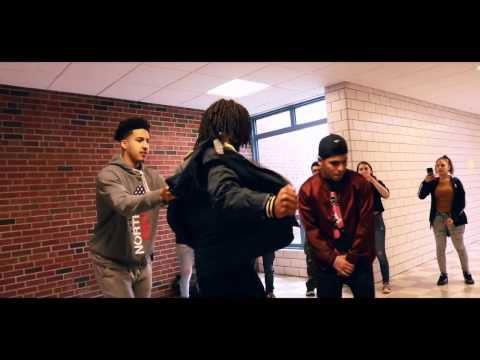The first time I watched “Holyoke High Fight! Stop Violence,” I expected to see a video of a couple kids beating on each other or a message from a parent-teacher association pleading for peace.
“Couple high school kids from Holyoke,” said an email from a colleague who passed along a YouTube link.
The video begins with two students in a Holyoke High School classroom talking about their clothes for an Instagram post. Then the camera shifts to focus on a confrontation behind them; a boy in a long brown coat and a Bruins sweater shoves another in a red silk jacket and cap sitting at a desk.
“You want to do this now?” one says.
The boys rush out into the hallway followed by the rest of the students in the classroom who are eagerly pulling out their smartphones to capture the fight, likely to later post the ugliness online.
Just as the first punch is about to be thrown everything freezes. The soundrack drops, and the young man in the silk jacket, Roshay, breaks apart from the stillness and begins rapping about how violence erodes communities as well as individual worth.
I wasn’t expecting to see art in this video, and I sure as hell wasn’t expecting music good enough to play in the club.
To be blunt: my expectations about a “couple high school kids from Holyoke” were garbage.
I’m one of the assholes this video is trying to reach.
“Holyoke High Fight! Stop Violence” is not just about stopping physical attacks, but challenging one of the many sources of this pain: racism, profiling, and stereotypes. The music video seeks to challenge what people might think they know about the city’s youth.
Holyoke knows a thing or two about being judged by people who don’t really go to the city; particularly its large Puerto Rican population.
“I want people to think twice about Holyoke,” Roshay said while we sat at a table with the track’s featured rapper, Ajnassudah, at the Dam Cafe in Holyoke. “It’s a Puerto Rican city and people think low of it.
“We’re both Puerto Rican,” Roshay said pointing to himself and Aj. “You hear people talk to the teachers in Holyoke and say things like, ‘Oh, it’s so good of you to do this, to save them.’ They think we need fixing.”
The song’s message is being well-received by people inside and outside of the Pioneer Valley. In just three days last week, the video had been viewed more than 133,000 times on Facebook and 22,000 times on YouTube. Roshay, aka Kenny Roche, 18, wrote the rap at the request of his girlfriend, Vianca Gonzalez, who was helping to organize the high school’s past week of action to stop violence. He asked his friend and frequent collaborator, Ajnassudah, aka Erick Ricardo, 17, to write some featured rhymes for the song.
“I know many people that resort to violence,” raps Roshay,
“Many of which, have been my friends
Many of which ended up getting chased by sirens
Now the whole school is being compared to an asylum”
The two didn’t write an anti-violence rap video that begins with a mock fight because everything’s always peaceful in the halls of Holyoke High. Students were disciplined 187 times during the 2015-2016 school year, according to the Massachusetts Department of Elementary and Secondary Education, a little more than a third of them for fighting or threatening an attack. Aj, who moved to Holyoke a year ago from Lawrence, recalled one day when there was a fight in every lunch period at the school.
The fights, however, are not what Holyoke High is all about, though it’s a trait for which they’re known, the young artists say. Roshay and Aj said fights happen, but it’s not a widespread problem; they’ve mostly been between the same group of students. Indeed, state data says there were 1,372 students at Holyoke High last year; which means that only 14 percent of the student population was involved in fighting — at most! This number assumes that each student disciplined for fighting was a unique student; it’s far more likely that there are some single students representing more than one instance of discipline.
“It’s like a select group of kids that don’t have the mindfulness,” Aj said, “the people who don’t consider, over time, how the things they do look.”
There’s a connection between the stereotypes and profiling Roshay and Aj are trying to upend and the racism that is fueling the nation’s anger toward immigrants and refugees: they are a micro and macro example of how unchallenged expectations can do serious damage.
When Donald Trump took command of the country on Jan. 20, he began to fulfill some of his most hateful campaign promises. He signed or drafted executive orders to strip federal funding from sanctuary cities — such as Northampton and Boston, banning Syrian refugees and maliciously restricting access to refugees as well as legal immigrants from Muslim countries, and building a wall on the U.S.-Mexican border.
While Trump can fire off as many executive orders as he likes — and the tantrum thrower-in-chief probably will file many throughout his tenure — it’s up to Congress to either uphold or oppose most major policy shifts.
Roshay and Aj don’t want others to think about Holyoke youth as violent problem children, but as the determined, proud, and bright people they are. And immigrants and refugees don’t want to be seen as violent loafers and rapists, but as the hard-working, productive people they are.
We need to see people for who they really are, not who we think they are. We have to think about where our individual prejudices come from — whether they be against something as silly as a food you’ve never tried, or as serious as a city you drive through without really seeing. Because we’ve all just had a wake up call that lazy assumptions can lead to hateful actions of presidential proportions.
Contact Kristin Palpini at editor@valleyadvocate.com.



